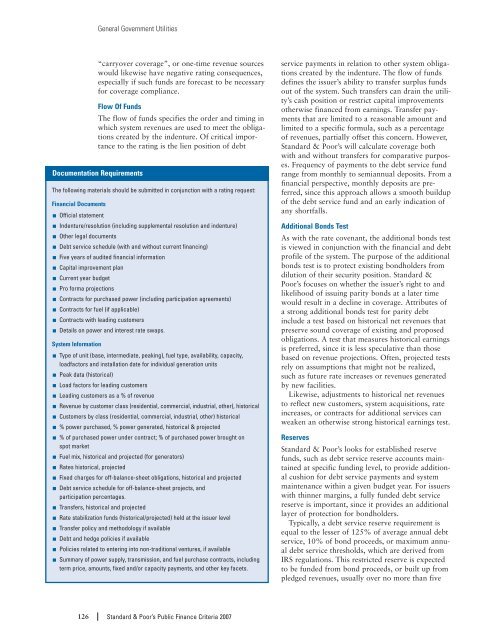S&P - Public Finance Criteria (2007). - The Global Clearinghouse
S&P - Public Finance Criteria (2007). - The Global Clearinghouse
S&P - Public Finance Criteria (2007). - The Global Clearinghouse
Create successful ePaper yourself
Turn your PDF publications into a flip-book with our unique Google optimized e-Paper software.
General Government Utilities“carryover coverage”, or one-time revenue sourceswould likewise have negative rating consequences,especially if such funds are forecast to be necessaryfor coverage compliance.Flow Of Funds<strong>The</strong> flow of funds specifies the order and timing inwhich system revenues are used to meet the obligationscreated by the indenture. Of critical importanceto the rating is the lien position of debtDocumentation Requirements<strong>The</strong> following materials should be submitted in conjunction with a rating request:Financial Documents■ Official statement■ Indenture/resolution (including supplemental resolution and indenture)■ Other legal documents■ Debt service schedule (with and without current financing)■ Five years of audited financial information■ Capital improvement plan■ Current year budget■ Pro forma projections■ Contracts for purchased power (including participation agreements)■ Contracts for fuel (if applicable)■ Contracts with leading customers■ Details on power and interest rate swaps.System Information■ Type of unit (base, intermediate, peaking), fuel type, availability, capacity,loadfactors and installation date for individual generation units■ Peak data (historical)■ Load factors for leading customers■ Leading customers as a % of revenue■ Revenue by customer class (residential, commercial, industrial, other), historical■ Customers by class (residential, commercial, industrial, other) historical■ % power purchased, % power generated, historical & projected■ % of purchased power under contract; % of purchased power brought onspot market■ Fuel mix, historical and projected (for generators)■ Rates historical, projected■ Fixed charges for off-balance-sheet obligations, historical and projected■ Debt service schedule for off-balance-sheet projects, andparticipation percentages.■ Transfers, historical and projected■ Rate stabilization funds (historical/projected) held at the issuer level■ Transfer policy and methodology if available■ Debt and hedge policies if available■ Policies related to entering into non-traditional ventures, if available■ Summary of power supply, transmission, and fuel purchase contracts, includingterm price, amounts, fixed and/or capacity payments, and other key facets.service payments in relation to other system obligationscreated by the indenture. <strong>The</strong> flow of fundsdefines the issuer’s ability to transfer surplus fundsout of the system. Such transfers can drain the utility’scash position or restrict capital improvementsotherwise financed from earnings. Transfer paymentsthat are limited to a reasonable amount andlimited to a specific formula, such as a percentageof revenues, partially offset this concern. However,Standard & Poor’s will calculate coverage bothwith and without transfers for comparative purposes.Frequency of payments to the debt service fundrange from monthly to semiannual deposits. From afinancial perspective, monthly deposits are preferred,since this approach allows a smooth buildupof the debt service fund and an early indication ofany shortfalls.Additional Bonds TestAs with the rate covenant, the additional bonds testis viewed in conjunction with the financial and debtprofile of the system. <strong>The</strong> purpose of the additionalbonds test is to protect existing bondholders fromdilution of their security position. Standard &Poor’s focuses on whether the issuer’s right to andlikelihood of issuing parity bonds at a later timewould result in a decline in coverage. Attributes ofa strong additional bonds test for parity debtinclude a test based on historical net revenues thatpreserve sound coverage of existing and proposedobligations. A test that measures historical earningsis preferred, since it is less speculative than thosebased on revenue projections. Often, projected testsrely on assumptions that might not be realized,such as future rate increases or revenues generatedby new facilities.Likewise, adjustments to historical net revenuesto reflect new customers, system acquisitions, rateincreases, or contracts for additional services canweaken an otherwise strong historical earnings test.ReservesStandard & Poor’s looks for established reservefunds, such as debt service reserve accounts maintainedat specific funding level, to provide additionalcushion for debt service payments and systemmaintenance within a given budget year. For issuerswith thinner margins, a fully funded debt servicereserve is important, since it provides an additionallayer of protection for bondholders.Typically, a debt service reserve requirement isequal to the lesser of 125% of average annual debtservice, 10% of bond proceeds, or maximum annualdebt service thresholds, which are derived fromIRS regulations. This restricted reserve is expectedto be funded from bond proceeds, or built up frompledged revenues, usually over no more than five126 Standard & Poor’s <strong>Public</strong> <strong>Finance</strong> <strong>Criteria</strong> <strong>2007</strong>
















